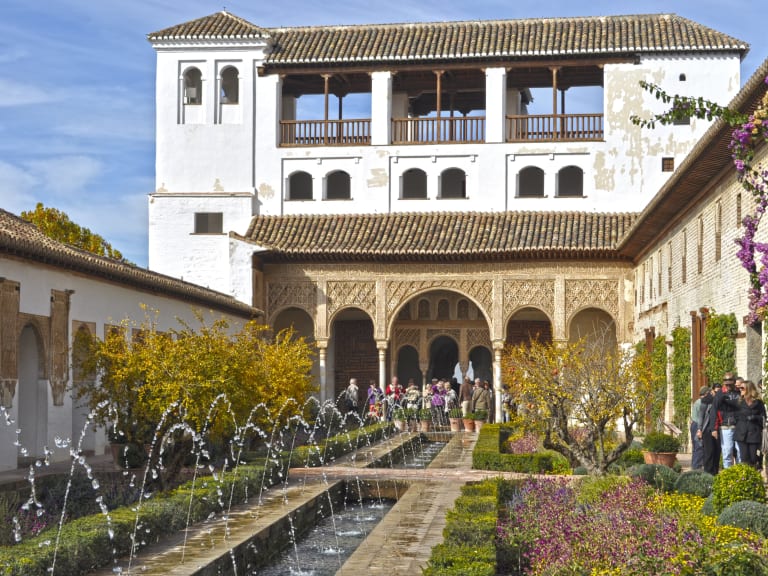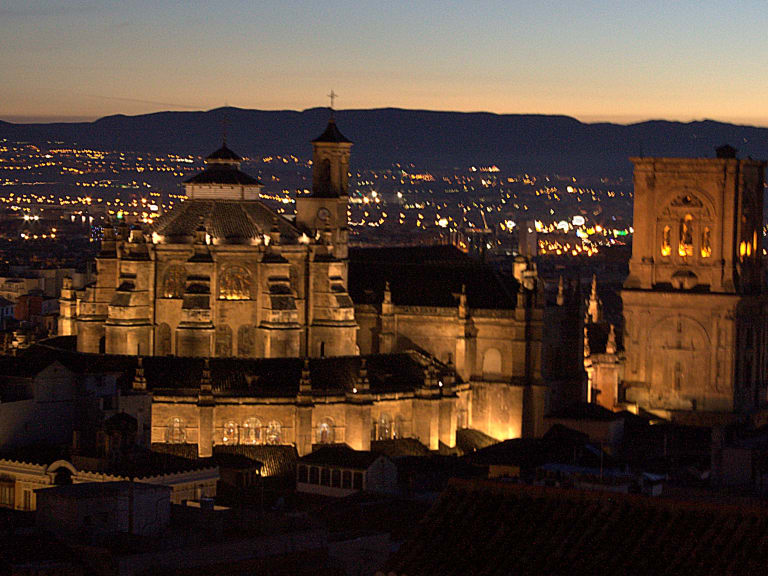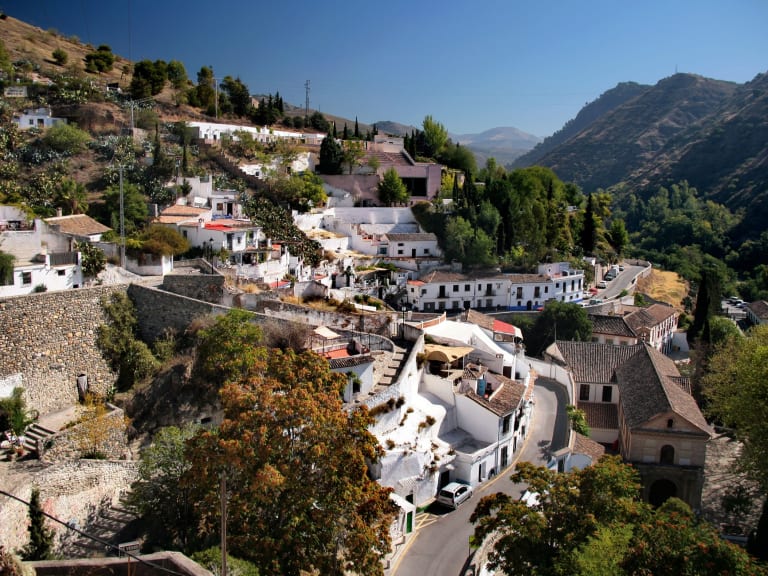More about: Best Things to Do In Granada In 3 Days
Granada is a city with a huge number of monuments to see and plans and activities to do. I would say that, to get the most out of your visit, you would need to spend at least 4 days in the city. But three days is enough to visit all the neighbourhoods, monuments and places concentrated in the city without having to leave its borders.
In 72 hours we have plenty of time to spend a good amount of time exploring the famous Alhambra and its surroundings without leaving anything out, another day to explore the monuments in the historic city centre and an extra day to visit the rest of the places that Granada has to offer.
Day 1: The Alhambra, the Generalife

The first day of this itinerary has a clear objective. To get to know its main monument, the Alhambra, and the surroundings of this place, recognised as one of the most important tourist attractions in Spain.
The route starts early in the morning at the Alhambra itself and ends at the Paseo de los Tristes at sunset to enjoy the views. Finally, the day ends in an ideal area for dinner and a stroll through Granada by night.
The Alhambra in Granada
The starting point of this three-day itinerary in Granada could not be other than its most famous monument and its main symbol, the Alhambra.
This monumental complex consists of several palaces and buildings that were home to the rulers of the Nasrid kingdom of Granada and later to the Royal family of the kingdom of Castile after the reconquest. Such is its importance that it regularly ranks among the top 2 or 3 most visited monuments in Spain.
It is advisable to start visiting early in the morning to avoid queues and to avoid the hottest hours of the day, especially in summer.
Tickets should be purchased weeks in advance as demand is extremely high and therefore can only be purchased by reservation, especially in high season.
General admission to the Alhambra includes the Alcazaba, the Nasrid Palaces, the Generalife, the Palace of Charles V and the Bath of the Mosque, which are its main attractions.
The Alhambra opens its doors every day of the week at half past eight in the morning. If you start your visit at that time, which I recommend, you will have enough time to tour the Alhambra at your leisure, about 4 hours.
Of course, you can also choose the option of hiring one of the guided tours of the Alhambra.
The Generalife

The Generalife is part of the monumental complex of the Alhambra, although it is located outside the Alhambra, practically next to it.
It is the royal residence of the sultans of the Alhambra and consists of its palace and its beautiful gardens full of fountains. These gardens are unique and the oldest of their kind in Europe.
The Palace dates back to the 12th and 13th century and grows around the well known courtyard of the irrigation channels, the heart of the building and one of the most photographed places in Granada.
The Generalife is open daily from 8:30am to 8:00pm in spring and summer, and from 8:30am to 6:00pm in autumn and winter. 2 hours are enough time to visit it and follow our itinerary to the next stop. You can find all the information about tickets at this link.
El Bañuelo
What is known as the Bañuelo is no more and no less than the oldest Arab baths in Spain and one of the best preserved.
They are discreetly located in a private house near the Alhambra and are open to the public every day of the week.
Together with the Alhambra and the Generalife, it is the essential monument to visit to see all the facets of Moorish Granada. Admission is about 5 euros per person but on Sundays you can visit for free.
Paseo de los Tristes
Known by the name of Paseo de los Tristes because the funeral processions used to pass through here, its real name is Paseo del Padre Manjón.
This street, which also houses the Bañuelo, is a beautiful promenade at the foot of the Alhambra and offers spectacular views of the Alhambra.
Assuming you visit late in the afternoon, it is a perfect place to end the day enjoying the walk and finishing off the day with dinner in one of the many tapas bars along the same promenade.
If you prefer, another option is to walk towards Plaza Nueva and choose from the many tapas bars around Calle Elvira, one of the most traditional streets in the city for dinner.
Day 2: Granada Cathedral, the Albaicín

After visiting the Alhambra area, the second day will be reserved for a tour of the historic centre of the city. The starting point is the impressive Cathedral of Granada in the heart of the city.
After visiting the Cathedral we will continue exploring the city centre on foot until we reach the Alcaicería area and the Albaicín where we will finish this second part of the itinerary.
Granada Cathedral and Royal Chapel
After the reconquest in 1492, the Catholic Monarchs wanted Granada to be a symbol of Christianity and for this reason they ordered the construction of a Gothic temple worthy of being the burial place of the kings.
You will see the spectacular result during your visit to Granada Cathedral. It is the most imposing building in the city centre and a must-see.
The monumental complex of the cathedral is made up of, in addition to the temple itself, the old Lonja and the church of the Sagrario next to the cathedral.
But the highlight is the Royal Chapel, a project of the Catholic Monarchs to become the burial place for their bodies on their death. Although they died before the chapel was completed, their bodies were later moved and still remain there today. It is one of the most outstanding places in Granada for its historical weight and artistic value.
The Corral del Carbón
This place is another example of the deep mark left by the Arabs in Granada. The corral del Carbón is an alhóndiga, a building used to house merchants and traders.
Located in the heart of the city centre, close to the cathedral, the corral del Carbón is the only building of its kind still standing in Spain and a remarkable example of Andalusian architecture. As admission is free, you can't miss this place, which dates back to 1336.
The Alcaicería

The name Alcaiceria is of Arabic origin and refers to an area of the cities of Al-Andalus used for craftsmanship and trade, especially in silk.
As one of the most important places of the Al-Andalus, Granada could not be without an Alcaiceria, and today it is preserved intact, maintaining its original function.
It is located in the historic centre of the city, also very close to the Cathedral, and in this market you can buy nowadays many samples of handicrafts, souvenirs, souvenirs and all kinds of productsthat are a perfect souvenir of your trip.
that are a perfect souvenir of your trip to Granada.
The Albaicín
In the afternoon, after visiting the main monuments in the historic centre, we move a little north to visit the most famous and oldest quarter of Granada, the Albaicín.
This is a neighbourhood of Arab origin and it is said to be like a city within a city. Its steep streets and houses predate even the Alhambra, and in fact the neighbourhood is situated on the hill just opposite where the famous Alhambra was later built.
With time and calm you can walk through its streets, see the facades of its white houses, enjoy the many viewpoints overlooking the Alhambra, such as San Nícolas, and discover why this neighbourhood was declared a World Heritage Site by UNESCO in 1994.
Wrapping up the day by watching the sunset from one of its viewpoints is an unforgettable experience. You'll also be able to eat some tapas in the area before returning to your hotel.
Day 3: Monastery of San Jeronimo, Sacromonte

After the first two days we can say that we will have visited the main monuments of Granada. But the visit will be incomplete.
There are still several places to visit, perhaps less frequented, but also very surprising. Most of them are located on a different route through the city centre and ending in the Sacromonte area and its peculiar caves.
It is a more relaxed and flexible route, perfect to end a three-day trip to Granada.
Monastery of San Jeronimo
The first stop on our third and last day in Granada is the monastery of San Jerónimo, in honour of the patron saint of Granada.
This was one of the first buildings and the first monastery to be built in Granada after the reconquest. Two elements of the monastery stand out, the interior courtyard formed by 36 arches and the church.
The latter was sacked by the French during their occupation centuries later, but still retains much of its artistic heritage. The clearest example of this is the spectacular altarpiece in the main chapel, a work for which it is justified to pay the 4 euros entrance fee and visit this beautiful building.
Basilica of San Juan de Dios

If after visiting the Cathedral of Granada you have fallen in love with it, which is quite likely, you should know that it is not the only baroque church in Granada. The Basilica of San Juan de Dios
was commissioned by the hospital order of San Juan de Dios to house the remains of this patron saint of the sick.
In fact, the saint's tomb is located inside and is one of the most interesting parts of the basilica.
Located on Calle San Juan de Dios, near the monastery of San Jerónimo, from the outside it may look like just another church to look at, but when you enter the interior you will be amazed by the church's gold-coloured decoration.
It is, in my opinion, one of the lesser known jewels of Granadas but one of the most surprising.
Royal Hospital
The Royal Hospital must be added to the list of Gothic buildings that the Catholic Monarchs ordered to be built in Granada.
After the reconquest, this building was erected to treat the war wounded and later served as an asylum for combatants. Today it is the seat of the University of Granada.
The hospital's interior courtyards in Mudejar style are outstanding, the most famous of which is the marble courtyard. The main façade and the Triumphal Gardens, located next to this building, are also worth a visit. A
lthough it is not the most impressive building in the city, it is a very convenient and quick visit to make this route through the best of Granada even more complete.
Sacromonte

Although the Albaicín is the most emblematic quarter of Granada, it is not the only one worth visiting in the Andalusian city.
In fact, tours of the Sacromonte neighbourhood usually go hand in hand with those of the Albaicín, although it has two elements that make it unique: its cave houses and the fact that it is the birthplace of flamenco in Granada.
As it is located on the slopes of a hill opposite the Alhambra, the gypsies who once lived there took advantage of the terrain to build their houses in the form of caves.
Many of these caves are places of worship among flamenco lovers as they are used for flamenco shows in a unique setting.
The best known of these caves are the Cueva de María la Canastera and the Cueva de La Rocío. There is also a museum in one of the caves which is designed to show the history and traditions of a neighbourhood where Arabs, Jews, Castilians and gypsies have lived side by side.
A mixture from which the multicultural charm of the neighbourhood has been inherited and which is an ideal place to end this three-day itinerary through the city of Granada.



